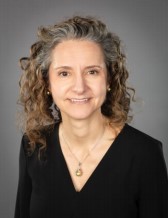
Our Spring Chemistry Seminar Series starts today! Dr. Ana de Bettencourt-Dias, a Susan Magee and Gary Clemons Professor of Chemistry from the University of Nevada, Reno, kicks off the series.
Her piece on Lanthanide Complexes with Dual Activity and Unusual Coordination Chemistry starts today at 3:00 pm, via zoom.
Abstract: The luminescence of lanthanide ions is based on f-f transitions. Due to the core nature of the 4f orbitals involved in the process, as well as the forbidden nature of these transitions, the emission properties make these ions uniquely suited for a variety of applications involving light emission, such as lighting, imaging, and sensing. Since the f-f transitions are forbidden, the emission is most efficiently promoted through coordinated chromophores. The use of these coordinated ligands provides unique opportunities. They can be functionalized to tailor the chemical and photophysical properties of the resulting complexes.1 We have used this approach to synthesize complexes that can be used as imaging agents for cancer cells.2 By extending the conjugation of the ligand we shifted the excitation wavelengths into the visible and isolated complexes that can be used as molecular nanothermometers.3In addition, we used carbazole-based ligands that enabled excitation of the resulting complexes in the biological window by a two-photon process. Finally, we used oligothiophene-based ligands to isolate complexes that luminesce and generate singlet oxygen.
In this presentation, I will discuss my group’s recent work on lanthanide ion complexes with dual activity, as well as some recent results on unusual coordination chemistry4-5 of these fascinating metal ions.
![Figure 1. Temperature-dependent emission spectrum of K3[Tb(dipicCbz)3]. Inset shows the intensity of the 5D4 → 7F5 transition as a function of temperature.](https://blogs.mtu.edu/chemistry/files/2021/01/de-Bettencourt-Dias-Chart.jpg)
References
- Luminescence of Lanthanide Ions in Coordination Compounds and Nanomaterials. de Bettencourt-Dias, A., Ed. John Wiley and Sons: 2014.
- Monteiro, J. H. S. K.; Machado, D.; de Hollanda, L. M.; Lancellotti, M.; Sigoli, F. A.; de Bettencourt-Dias, A., Selective Cytotoxicity and Luminescence Imaging of Cancer Cells with A Dipicolinato-based EuIII Complex Chem. Commun. 2017, 53, 11818-11821.
- Monteiro, J. H. S. K.; Sigoli, F. A.; de Bettencourt-Dias, A., A Water-soluble TbIII complex as temperature sensitive luminescent probe. Can. J. Chem. 2018, 96, 859-864.
- de Bettencourt-Dias, A.; Beeler, R. M.; Zimmerman, J. R., Anion-π and H-Bonding Interactions Supporting Encapsulation of [Ln(NO3)6/5]3-/2-(Ln=Nd,Er) with a Triazine-based Ligand. J. Am. Chem. Soc. 2019, 141, 15102-15110.
- de Bettencourt-Dias, A.; Beeler, R. M.; Zimmerman, J. R., Secondary-Sphere Chlorolanthanide(III) Complexes with a 1,3,5-Triazine-Based Ligand Supported by Anion-π, π-π, and Hydrogen-Bonding Interactions. Inorg. Chem. 2020, 59, 151-160.
Bio: Ana de Bettencourt-Dias received her ‘licenciatura’ (MS equivalent) in Technological Chemistry from the University of Lisbon in 1993, and her ‘Dr. rer. nat.’ (PhD equivalent) in Inorganic Chemistry from the University of Cologne in 1997 with Prof. Thomas Kruck. In her graduate work, she isolated new titanium complexes as single source precursors for the chemical vapor deposition of TiN thin layers. She joined the group of Prof. Alan Balch at UC Davis in 1998 as a Gulbenkian postdoctoral fellow, where she studied the electrochemistry and structure of fullerenes and endohedral fullerenes. In 2001 she joined the faculty at Syracuse University and started her work on luminescent lanthanide ion complexes. She moved to the University of Nevada, Reno, as associate professor in 2007 and was promoted to professor in 2013. Her research centers on light-emitting compounds and coordination chemistry of the f block of the periodic table. She served on the editorial advisory board for Inorg. Chem. from 2013 to 2015, and has been a managing member of the editorial board of the Journal of Rare Earths since 2014. She was program chair of the 2011 and conference chair of the 2014 Rare Earth Research Conference, organizes the lanthanides and actinides symposia at the national meetings of the American Chemical Society and was the 2019 Chair of the Division of Inorganic Chemistry of the American Chemical Society. She served as the Associate Vice President for Research at UNR from 2015 to 2019. She returned to being a full-time faculty in July 2019, and is now the Susan Magee & Gary Clemons Professor of Chemistry.